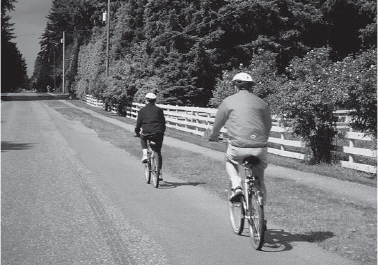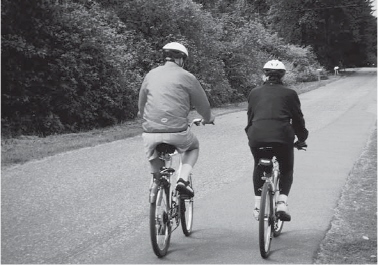
Cycling is not an inherently dangerous pastime. Popular opinion would like us to believe that we risk our lives when we venture onto the roads. Not so. The statistics suggest that cycling fatalities are among the lowest of many categories of recreational and non-recreational activity.
Nonetheless, cycling safety requires more than donning a helmet, which, as manufacturers warn, provides no protection to parts of the body that it does not cover. All cyclists can substantially reduce the possibility of accidents by following a few tried and true guidelines for minimizing cycling risk:

Right

Wrong
> Keep well to the right of the road, out of the way of overtaking traffic.
> Cycle in single file when travelling with others. Cycling abreast increases the risk to the outside rider and makes it more difficult for a driver to pass safely. Yes, we know that cycling in single file inhibits conversation, but it reduces risk.
> Leave 3 to 4 metres between you and the cyclist ahead of you, and don’t allow another rider to follow closely behind you. A sudden stop or a change of direction by either one of you can cause a collision, knocking both of you off your bikes.
> Check your rear-view mirror frequently. Advance notice of traffic approaching from behind—including hell-bent cyclists—reduces surprises and consequently saves you from accidents.
> When riding downhill, raise your body slightly off the saddle to shift more weight onto the pedals. This body position, combined with the suppleness of your knees, gives you much better control over your bicycle if you hit a bump or other irregularity at speed. Resist the temptation to let loose on the downward grade; keep your speed to the point where you know you can brake to a full stop within the distance you can see. If you go too fast into a blind bend, you might swing wide over to the far side of the road and into oncoming traffic.
> Approach left turns with great care. Make your intentions clear by signalling with your arm. Move toward the middle of the road and make your turn when it is safe to do so. Don’t ride across the path of oncoming traffic. If traffic is heavy, be prepared to dismount and walk your bicycle across two sides of the intersection. In short, you can’t be too careful when turning left at busy intersections.
> Dismount and walk your bike across oblique railway tracks. If you want to ride across them, ensure that there’s no road or rail traffic approaching the crossing from any direction. If there is, stop until it has passed. From a short distance back, ride to a position where you are facing the tracks at a ninety-degree angle. Cross the tracks straight on and resume your ride on the right side of the road.
> Wear eye shields, preferably slightly tinted wide-angle shields that will not impede your field of vision. If you cycle often, something—dust, insects, small pebbles—will fly into your eyes occasionally, possibly resulting in a fall. Light plastic shields will protect your eyes and usually prevent this kind of accident.
> Practise dismounting rapidly so that you can do this instinctively and safely if you must stop in a hurry.
> Keep an eye out for dogs, and stay calm when they appear without warning. Try not to brake suddenly or swerve. Often, the stern command “Stay!” will deter a chasing dog. In our experience, it is best to keep going; when you leave its territory, the dog will usually give up.
> Be watchful when passing parked cars. A door could be opened into your path.
> Obey the rules of the road, including stop signs and red lights. Cyclists have the same responsibilities and rights as drivers. The Motor Vehicle Act and municipal bylaws apply to cyclists, too. Do not ride on sidewalks except where it is specifically allowed. Even then, give pedestrians the right-of-way and pass them only at low speed. Walk your bike when using a pedestrian crossing.
> On dykes and trails, expect to meet walkers, dogs (which should be on a leash but often aren’t), children, horses (which can be nervous) and other cyclists. Ring your bell when approaching from behind and overtake slowly, not aggressively. Remember that most of these users have the right-of-way over cyclists.
Your safety is not a matter of chance; it is overwhelmingly in your own hands. Recognize the risks and what you can do to reduce them. Then, irksome though you may find them at first, follow these rules. By doing so, you reduce the risks of cycling because you put yourself in control.
In conclusion, we repeat that the first rule of cycling safety is to ride well to the right of the road in single file. Nothing else ranks in importance with this golden rule. It maximizes your chance of staying out of trouble every moment of every ride.
A Note about Cycling Behaviour
Today, governments at all levels have done much in the way of providing more cycle paths and dedicated routes in order to encourage cycling. As a result, many more cyclists are on the roads, trails and dyke paths than when we wrote the first edition of Easy Cycling around Vancouver. Fortunately for cyclists in general, the effect has been a greater awareness of the benefits of cycling and the rights of cyclists.
Unfortunately, however, letters to the editor printed in newspapers indicate that some other road users and pedestrians are becoming increasingly irritated by the dangerous riding habits and discourtesy of a few cyclists. In order to curb this growing hostility, we must act positively to build and maintain goodwill among cyclists, pedestrians and drivers. We make this appeal to our readers: Please ride with consideration toward others. Be a responsible road user.